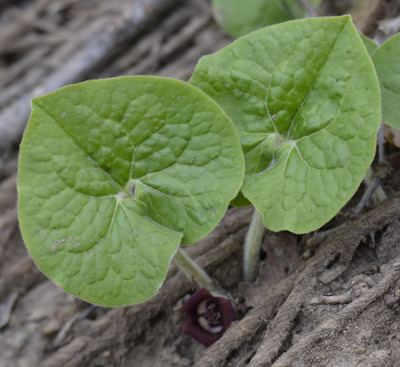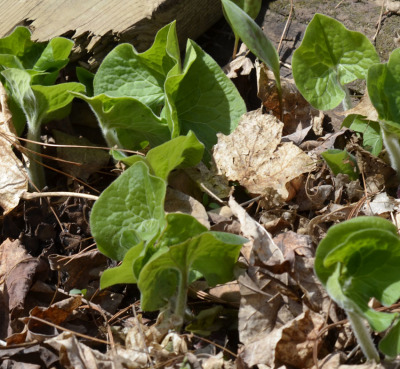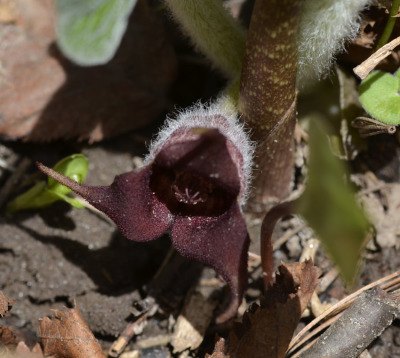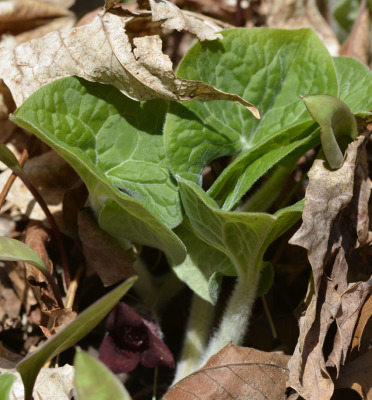While walking under a canopy of mature maples and oaks that had not leafed out yet, I looked for interesting wildflowers. Some puzzling vaguely violet-like lush green leaves caught my eye. They were much too fleshy and thick to be violets. Then I noticed the small dark red, almost purple-black blossoms hidden at the base of the larger plants. I’d just seen this plant while leafing through my field guides looking for the mysterious purple-grey leaves of Blue Cohosh. These were Wild Ginger.

The leaves can be vaguely violet-shaped.
Is Wild Ginger Related to the Ginger Root We Use in Stir Fries and Baking?
No, it’s not.
The root has been used as a spice but this is no longer recommended because two chemicals it contains are known carcinogens. The amount of those chemicals can vary from plant to plant according to the USDA Forestry website.
One creature that has been known to eat this plant is the Pipevine Swallowtail caterpillar according to the USDA website and the USDA forest service website.
Why Do People Collect Wild Ginger If It’s a Different Plant?
I suspect some of them pick it not understanding that it is not just the uncultivated form of domestic ginger. That’s a shame because this is not an abundant wildflower, at least not here in southern Ontario.
If you want to risk consuming Wild Ginger, I’d suggest you contact a nursery that carries rhizomes for sale that you can grow in your own shade garden. Personally, I wouldn’t chance eating this plant.
What Pollinates the Flowers of Wild Ginger?
The ginger flowers are quite low when they bloom. I actually had to move several dead leaves out of the way to get a clear look at the flowers. So I wondered what provides the pollination. Wind seems unlikely. Bees, wasps and flies are starting to move around when the flowers come out but they aren’t abundant yet. And would they work so hard to find flowers buried in last autumn’s leaves?

Aside from the ones I exposed, the flowers are under the dead leaves.
I didn’t really expect to find a clear answer to my question or an interesting story about the pollinators but I did. The US Department of Agriculture Forest Service website says that the flowers are deliberately low under the leaves to attract certain flies that emerge from the ground early in the spring which usually feed on the carcasses of animals that died during the winter. The flies have been found in the blossoms eating the pollen. It’s believed they may move to other nearby blossoms and accidentally transfer some pollen although this has not been satisfactorily proven.
The site also says that like trilliums, the seeds are believed to be taken underground by ants that consume only part of the seed and leave the rest to sprout into a new plant.
I was pleased to see Wild Ginger plants have also been re-introduced at a nearby park. I hope that no one mistakenly picks them instead of leaving them alone to flourish. Most Wild Ginger plants grow by spreading rhizomes rather than from seed. I’ll check next spring to see if the new colonies have become established.
Related Reading
- What Purple Grey Silver Red Leaves Are Springing Up in the Forest?
- Why Do These Trilliums Have a Racing Stripe?
Join In
Do you have a Wild Ginger patch in your local park? Has anyone mistaken it for domestic ginger? Please share your insights with a comment.


